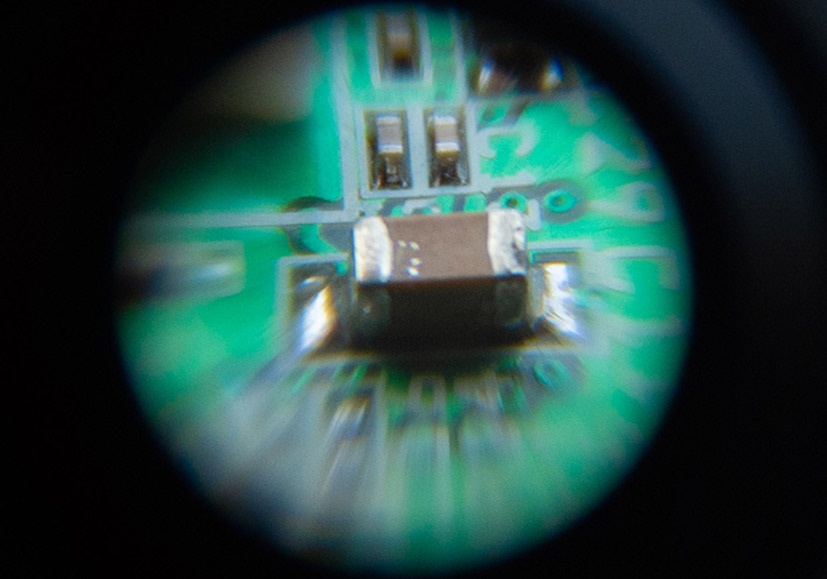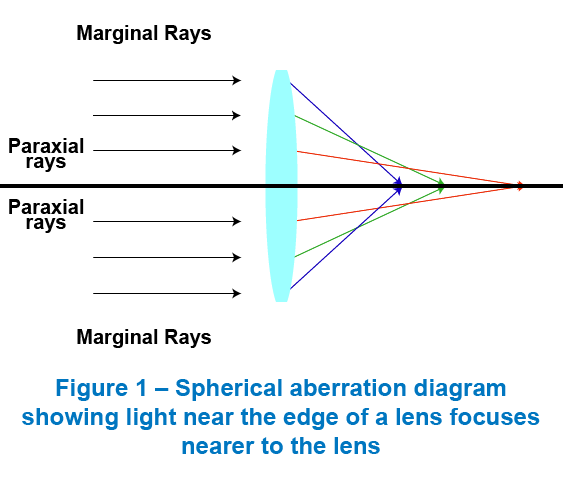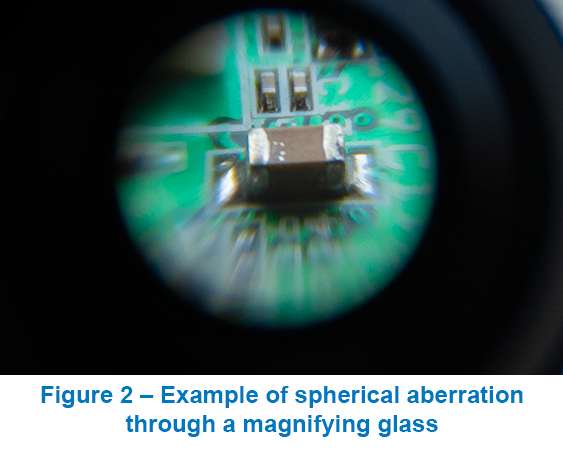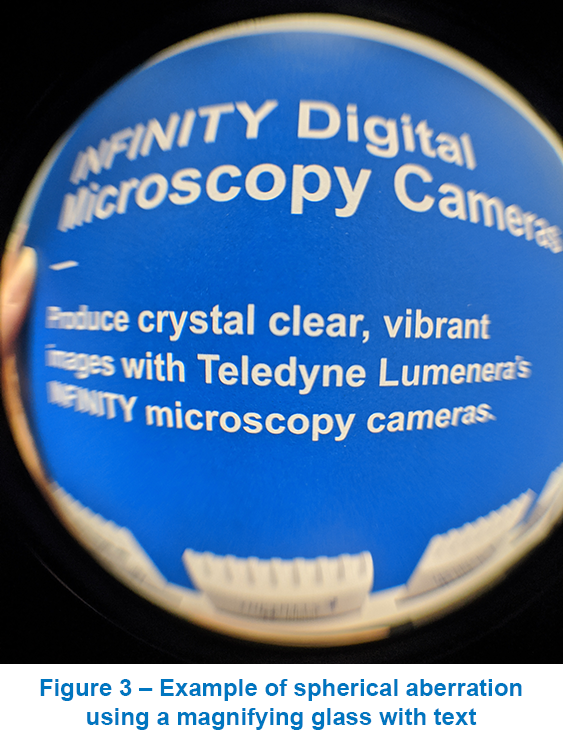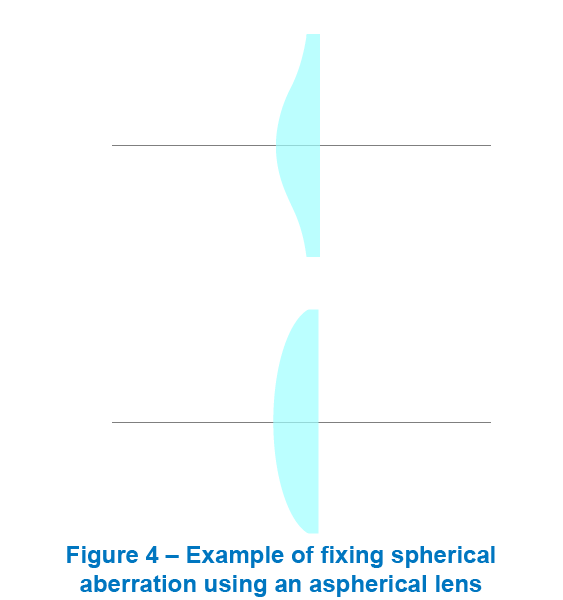What is spherical aberration and why does it happen?
Even with sophisticated lens systems, it can be difficult to get an entire image in focus. With any spherical surface, light will bend differently depending where on the surface the light is passing through. In Figure 1 below, light is refracting at different angles, where the steeper the curve on the lens, the larger the angle of refraction. In the case of a camera lens that uses spherical glass, the surface near the edge of the glass will always refract light at a steeper angle. This will cause some incident light, primarily the light closer to the edge of the curved surface, to focus before the desired focal plane. This phenomenon is called spherical aberration.
Spherical aberration is the blurriness at the edge of an image. Using a spherical lens on a camera causes light near the edge of the lens (farther from the optical axis) to converge closer to the lens (shown in Figure 1). The light rays near the optical axis are referred to as paraxial rays and the rays near the periphery of the lens are the marginal rays. It should be noted that almost all optics found in cameras use spherical lenses.
This is similar to how a magnifying glass focuses best through the center of the lens. Figure 2 highlights this where the circuit is in focus near the center, but the rest of the circuit board, especially the text, is out of focus.
Another example of spherical aberration can be seen in Figure 3 where a magnifying glass is used to image the text on a Teledyne Lumenera brochure. In this image the center of the text (“Teledyne”) remains in focus. However, the text is out of focus at the edges of the image. This is exaggerated by the barrel distortion in Figure 3, but in a practical setting, spherical aberration could result in blur and losing vital image data near the edges of a frame.
Why does spherical aberration matter in imaging applications?
Image clarity is the biggest reason why spherical aberration must be considered when designing a vision system. When not corrected, the resulting image can have slight or even strong blur along the edge. In some cases, this can be to the point that the image may “cut off” a vital part of the target or environment. Without edge-to-edge sharpness the process of image analysis can become much more difficult.
In applications such as precision agriculture that use a very wide field of view from high altitude, it is critical to ensure that the same edge-to-edge sharpness is always present. This is especially true when post processing is done to help with the analysis, such as NDVI for monitoring the health of crops, or by using software that takes advantage of higher bit depths to actually produce the analytics itself. To understand NDVI and more about why bit depth is important for image analysis, read Teledyne Lumenera’s blog posts on, "Vegetation Indices Measuring Vegetation Health With Digital Imaging" and "An In-Depth Look At Bit Depth."
In aerial imaging, software stitching is used to combine images into larger mosaics. This can be done with multiple cameras to multiply the number of pixels that are capturing the image data. However, if spherical aberration is involved this could prove difficult due to the lack of edge sharpens. When stitching images together, a level of overlap is required to ensure that the images align properly. Without enough of the edge of each image in focus, the ability for software to align and stitch the images will be affected. Therefore, more of each image may need to be used for overlapping to compensate for a lack of clarity, effectively reducing the number of pixels being used to image unique information. For further information on using multiple cameras in aerial imaging, read our white paper, "Using a Single Versus Multiple Cameras in Aerial Imaging."
It comes down to selecting the right lens
In early optical systems that used single lens elements, the solution to spherical aberration was to add a small aperture. By having a narrow path for light to pass through, the out of focus light coming from the edges of a lens will be blocked and only allow light to pass near the center of the lens. This results in a sharper image, but also reduces the brightness. Therefore, using a lens system that corrects for spherical aberration helps prevent poor image quality while retaining the desired amount of light. However, even with modern lens designs that try to adjust for spherical aberration, using a smaller aperture is still a common solution for getting the full frame in focus when there is adequate lighting. To better understand how aperture plays a role in imaging, see the Teledyne Lumenera blog post, "Improving Imaging System Performance with Lens Aperture Optimization."
For industrial applications, it can be more challenging to find a solution when the camera is not being used in a controlled setting (e.g. microscopy). Lens manufactures may have higher quality lens designs that correct for several types of aberrations, but spherical aberration will still occur to some extent with most lens systems that use spherical glass. Even if there are corrections in place, it is a physical limitation for spherical glass to focus all incoming light at one point. However, proper lens design can largely adjust for spherical aberration and produce images that capture all the important details.
One way a lens can correct for spherical aberration is by adjusting the physical shape of the lens elements. By grinding a lens so that it protrudes more near the center and making some adjustments to the edges, the lens can correct for focusing at the edge and allow all light to align properly. An example of this is an aspherical lens seen in Figure 4. In this image a standard spherical lens is compared to an aspherical lens. Several points of focus are produced by the standard lens, but this is fixed by introducing an aspherical lens in its place, focusing all the light to one point.
Depending on budget, choosing a lens will be based on a variety of factors, not just how well it can correct for spherical aberration. Special optics can be purchased for microscopy and even software solutions exist to assist with image correction, such as Teledyne Lumenera’s INFINITY ANALYZE 7, with built in spherical aberration correction. However, the physical limitations of a lens can not be completely overcome, due to a variety of lens options, there will never be just one lens that can always produce a “perfect” image. Various types of lenses are often necessary for any professional, since there will constantly be new targets to image and environments in which to image. In real-world applications, spherical aberration is bound to come up, but with modern technology, images can virtually omit any defects the human eye can detect.
For hundreds of years, new developments have continued to improve the quality of optics. Trying to enhance image quality one step at a time has been a consistent trend within the camera industry. At the time of writing this blog post, there have been relatively recent discoveries published in the Journal of Applied Optics (Doc. ID 351567) for designing lenses free of spherical aberration. This goes to show that advances in optical systems are continuing to develop as they always have been. Lens manufactures will continue to design and produce more options with finer details and improve upon previous generations.
So, understanding which lenses to purchase can be difficult. For any questions regarding Teledyne Lumenera cameras and finding compatible lenses that fit a specific application, Teledyne Lumenera’s imaging experts are always available. Reach out at [email protected].
And, sign up for our newsletter to automatically receive regular updates from Teledyne Lumenera.

